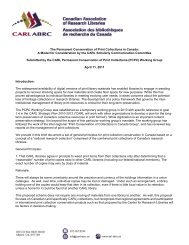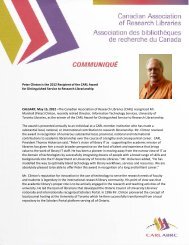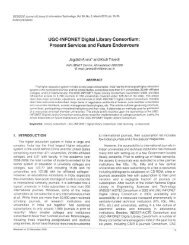PDF - CARL - ABRC
PDF - CARL - ABRC
PDF - CARL - ABRC
You also want an ePaper? Increase the reach of your titles
YUMPU automatically turns print PDFs into web optimized ePapers that Google loves.
scholarship through hybrid scholarly publishing models.<br />
The Value Proposition of OA to the HE and Scientific Community<br />
Successful implementation of OA policies, programs and publishing models will require close<br />
collaboration between researchers, university research offices, libraries, research funders, and<br />
publishers, in order to “align the intellectual and economic models for scholarly publishing with the<br />
needs of contemporary scholarship and the benefits, including low marginal costs of distribution, of<br />
network technology. 6 ” These are highly desirable outcomes, however, the key goal of Open Access is to<br />
advance science by removing barriers scientists face in accessing other scientists’ work. Not only does<br />
OA help advance science, but it brings the potential to accelerate the speed at which it moves. In<br />
physics, where open access has been commonplace for over a decade, the OA digital repository arXiv,<br />
hosted at Cornell University, provides free access to copies of almost every article published in most<br />
fields of physics (e.g. high‐energy, condensed matter, astrophysics, etc.), deposited by authors for<br />
anyone to use. A study from Southampton University (U.K.) has measured the time between article<br />
deposits into arXiv and when citations to these begin to appear. The research has shown the interval to<br />
be shrinking as the online repository has come into near‐universal use among physicists taking<br />
advantage of the immediate access to their colleagues’ research results. This system shortens the<br />
research cycle, accelerating progress and increasing efficiency in the area of physics 7 .<br />
Open access is good for education and good for research; by broadening the dissemination of the results<br />
of scientific inquiry and discourse, it supports the core mission of the higher education enterprise – its<br />
ongoing commitment to the advancement of knowledge. The present system of scholarly<br />
communication does not always serve the best interests of higher learning institutions or of the general<br />
public that should enjoy the benefit of accessing the results of the research activities it funds. Greater<br />
adoption of open access publishing models, activities, policies and mandates will challenge all parties<br />
with a stake in the dissemination of scholarship to find creative solutions to continue supporting<br />
scientific communication, but they need not compromise a successful balance of interests 8 . The research<br />
community, as a whole, and publishers alike benefit from open access.<br />
Researchers<br />
‐ Potential for greater exposure for their work<br />
‐ Greater access facilitates discovery and use of research beyond traditional disciplinary boundaries<br />
leading to interdisciplinary scholarly convergences that yield more discoveries and innovations<br />
‐ Opens the door to future collaborations at various levels (local, regional, national and international)<br />
‐ Greater control over intellectual property, by negotiating balanced copyright agreements with<br />
prospective publishers<br />
‐ Greater flexibility over how they use the products of their own research<br />
6 An Open Letter to the Higher Education Community, April 23, 2010<br />
http://www.provost.harvard.edu/reports/FRPAA_Open_Letter.pdf<br />
7 Alma Swan, Open Access and the Progress of Science, American Scientist, Volume 95, May‐June 2007<br />
http://www.americanscientist.org/libraries/documents/2007327142636_307.pdf<br />
8 Open Letter, op. cit.<br />
3












